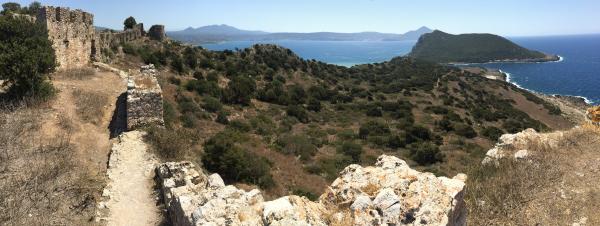How did former civilizations, such as the ancient Greeks and Romans, restructure their environment and how do their impacts compare with those of modern industrial society? Today in the Mediterranean, 98% of marine resources (from algae to whales) are depleted to less than 50% of their former abundance. Yet, anecdotal evidence suggests over-exploitation is not exclusively a modern issue. On land, the invention of bronze axes was sufficient to produce widespread deforestation. Indeed, many cities of antiquity–Troy, Myceneae, Ephesus–were built close to shore, but are now miles inland as soil erosion from cutting the forests extended the coastal plains seaward. People also heavily exploited ocean resources. For example, Seneca complained in the first century AD that fish had to be imported due to overfishing near Rome. The use of torches for night fishing was banned as early as the 2nd century BC in Corsica, ‘because it removed so many fish’. Under the guise of the new Center for Marine Archaeology, we are launching an international research expedition to turn anecdotal evidence into the first detailed, quantified evaluation of the timing and trends in social modification of marine ecosystems.
In October 2016, I, and a multinational team from the US, Germany, Greece, and Italy, proposed an interdisciplinary study of terrestrial and marine ecosystem change during the rise of Mediterranean civilizations. Recently, we were informed that our cruise proposal was accepted to use the German research ship “Meteor” (image below) to core high-deposition-rate sequences from the Aegean and Adriatic Seas from December 27, 2017 to January 22, 2018.
These marine sediments will be used to decipher environmental change across the coastal zone to quantitatively identify the impact of growing civilizations on coastal ecosystems between the Stone Age (~10,000 years ago) and the Present day. Among the targets for study are the Gulf of Argos and the Gulf of Navarino in Greece–respectively, offshore of ancient Mycenaea (famous for its role in the Trojan Wars) and the Palace of Nestor, home to the “Griffin Warrior” and the first monumental buildings in Europe. [The Gulf of Navarino (see image below) was also the site of a major naval battle in 1824, so when we take sediment cores there we will have to watch out that we do not hit a cannon!]

Terrestrial environmental changes will be deduced using changes in vegetation, aridity, and erosion rates within a high-quality marine-based age frame. For the marine realm, our analyses will yield the first quantitative assessments of fish populations and reconstructions of the marine food web during the growth of the first export fishing economies.
Our ‘master records’ of Holocene ecosystem change in the E Mediterranean region will yield critical new insight into the sensitivity and resilience of Mediterranean civilizations to environmental change and the vulnerability of marine ecosystems to early human impact. The study will also nail down the start of the “Anthopocene”–the time when humans become dominant architects of coastal ecosystems. Finally, the expedition will vividly demonstrate the sensitivity of the coastal environment to the growth of human society and help to point the way to restoring the biodiversity of the Mediterranean.
What did Classical Greek and Roman society do to the environment they inhabited? In 2018, we will launch the “Empire Expedition”–a research cruise to the eastern Mediterranean. This cruise will unite an international team of archaeologists, historians, paleontologists and marine geologists for an integrated study of the impact of growing human societies on their environment.
